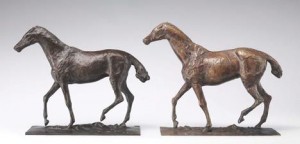The link to Degas
Where did the purported plasters come from?
By Martin Bailey

Left, a Hebrard cast from the master bronze, and a newly cast version from the Valsuani plaster (Copyright The Degas Sculpture Project Ltd. All Rights Reserved. Photo: Joseph Coscia, Jr)
Some may say that it sounds too good to be true that a full set of Degas sculptures should be discovered nearly a century after his death. So where do they come from?
Art dealer Walter Maibaum has described how he was shown the plasters in December 2004 at the Valsuani Foundry, by its proprietor Leonardo Benatov. They were in a locked room at the far end of the workshop: “Inside were 74 Degas plasters that were completely unknown to anyone outside the foundry or its close associates. To me it was the equivalent of opening King Tut’s tomb in Egypt or uncovering the terracotta warriors in China. The moment I gazed upon these remarkable plasters I instantly knew that everything that had been written about Degas’ sculptures in the past had to be reconsidered.”
Fellow dealer Gregory Hedberg also argues that these plasters can be traced to Degas. Hedberg believes the plasters were made between 1887 and 1912 by the artist’s close friend, sculptor Paul-Albert Bartholomé, from wax originals. Among the evidence, they cite a letter from Degas (probably from 1892) which suggests that Bartholomé was routinely making plasters from his waxes, although the reference to “vos précieux morceaux de plâtre” (your precious pieces of plaster) is not entirely clear.
After Bartholomé’s death in 1928, his studio and contents were inherited by his second wife, Florence Letissier. She was confined to a mental institution in 1955 and died four years later. Benatov says he was told by a deceased foundry manager that the plasters had been brought to Valsuani in 1955 by Albino Palazzolo, the master caster for Hébrard. Hedberg believes that Palazzolo would have been informed about the plasters. When Benatov bought the foundry in 1981, the casts were in a warehouse. Although this chain of provenance is plausible, the key steps are undocumented. An authentication of the plasters therefore must rest upon technical examination and connoisseurship.
| The Art Newspaper |


This Post Has 0 Comments